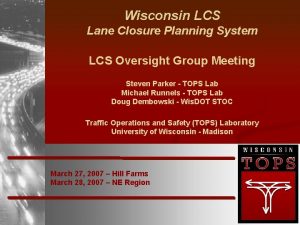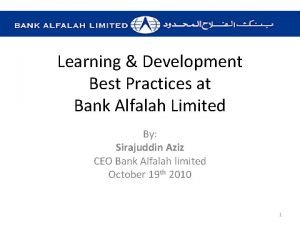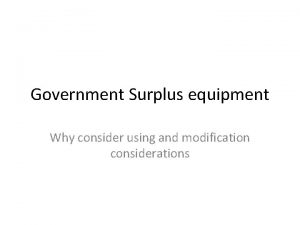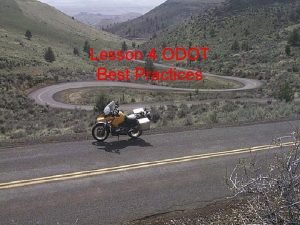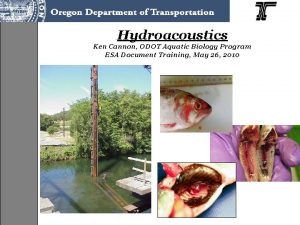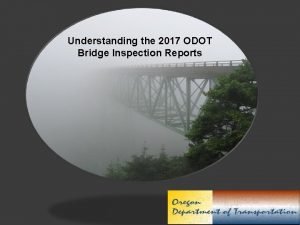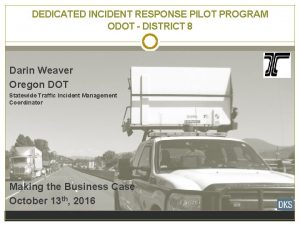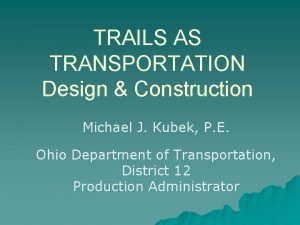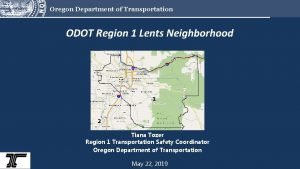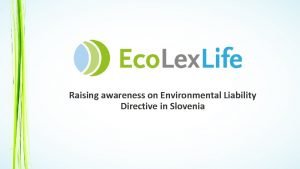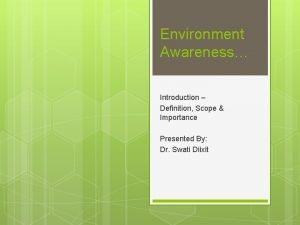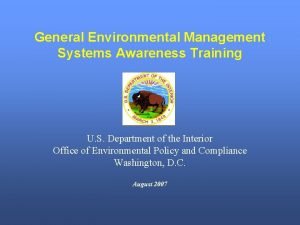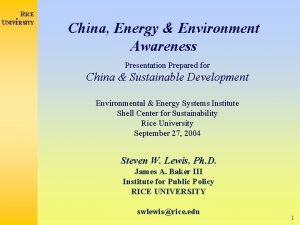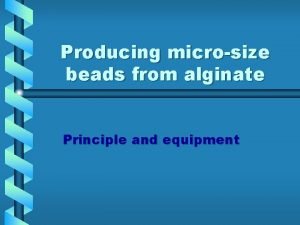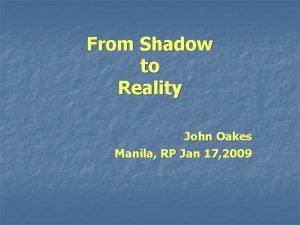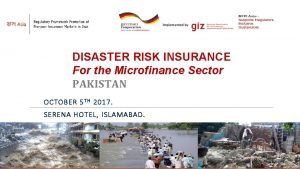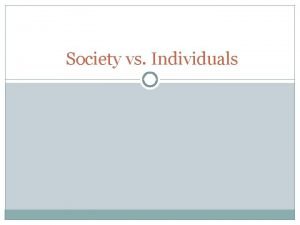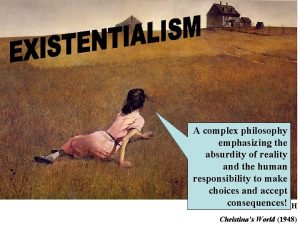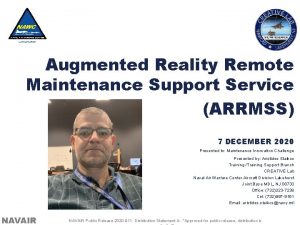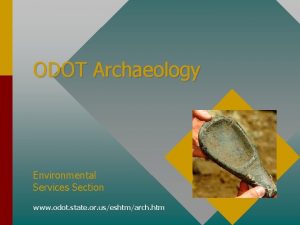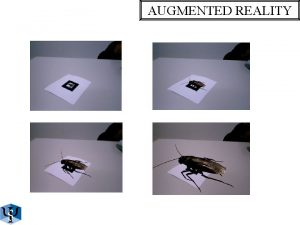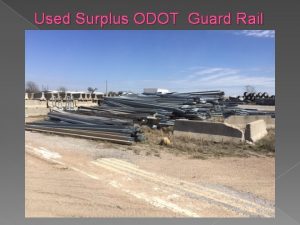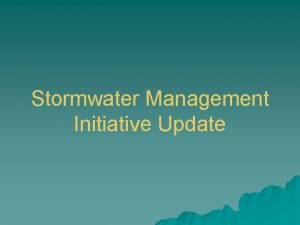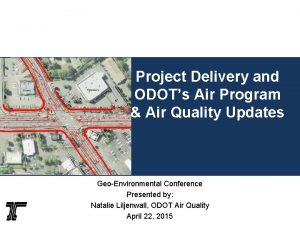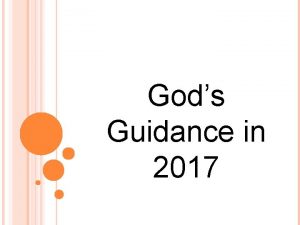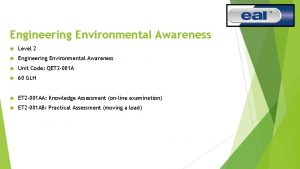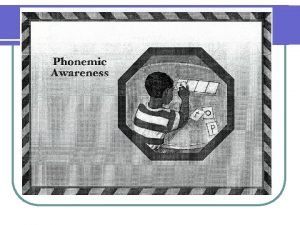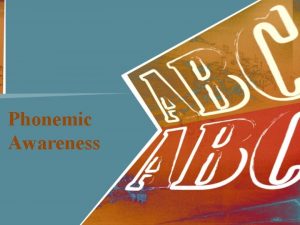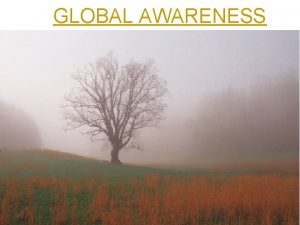ENVIRONMENTAL AWARENESS ODOTS ENVIRONMENTAL REALITY ODOT Environmental Guidance













































- Slides: 45

ENVIRONMENTAL AWARENESS

ODOT’S ENVIRONMENTAL REALITY

ODOT Environmental Guidance Statement GUIDANCE STATEMENT • ODOT will carry out its mission consistent with sound environmental stewardship and best management practices. We strive to meet the spirit and intent of environmental laws. We comply with regulations, and we will enhance the environment, balancing such enhancement with the scope and purpose of our ODOT mission. • Valuing Oregon’s environment is the responsibility of every ODOT employee and it is reflected in our decision and actions.

Definition of the term “Environment” All of the external factors affecting an organism, including living organisms and non-living variables such as water, soil, climate, light and oxygen. All of these factors together make up the environment.

Best Management Practices b Avoid b Minimize b Mitigate

Resource Topics b Archaeology b Historic Resources b Biology and Endangered Species b Water Quality b Wetlands b Air Quality b Noise Quality b Erosion Control b Hazardous Materials

Archaeology in ODOT

Potential range of impacts: b Ground disturbance: • Staging of equipment and material • Embankment • Guardrail installation/flarin g • Culvert extensions, etc. • Other ground disturbing

Historic Resources b What are Historic Resources? • Buildings, Sites, Objects, etc. , which are significant in history • Must be at least 50 years old • Must meet eligibility criteria for the National Register of Historic Places for federal regulatory laws to apply

Maintenance Project Issues Historic Resources b Bridge rails, transition rails, guardrail b Masonry features - parapet rails, culverts, stone facing, pedestrian features b Memorial features - historic signs, plaques, markers b Effects to setting - fill, removal of landscaping, new visual elements

Biology and Endangered Species

SMA’s for Plants and Wildlife b Sensitive Management Area (SMA) is a voluntary program initiated by Environmental Services in 1994 in response to the increasing number of state and federally listed species and resources found along ODOT right-of -way. There approximately 40 SMA sites found along ODOT right-of -way

RES and RAZ Mapping Tools ba tool that field crews could use to help avoid impacts to sensitive resources. b RES (Resource and Sensitive Area) b RAZ (Restricted Activity Zone)

RAZ Map example

Endangered Species • The federal Endangered Species Act (1973) requires agencies “insure that their actions are not likely to jeopardize the continued existence of endangered or threatened species or result in the destruction or adverse modification of critical habitat of such species. ” • U. S. Fish and Wildlife Service (USFWS) regulates listed plants, wildlife, invertebrates (including birds), and resident fish. • National Oceanic and Atmospheric Administration Fisheries (NOAA Fisheries)

Endangered Species Act ESA defines “take” to include: -- “harass, harm, pursue, hunt, shoot, wound, kill, trap, capture, or collect…” -- “Harm” is further defined to include: “…significant habitat modification or degradation that results in death or injury…” -- “Harass” is further defined to include: “…significantly disrupt normal behavior patterns which include, but are not limited to, breeding, feeding, or sheltering”. --Critical Habitat - “the specific areas within the geographical area occupied by the listed species on which are found those physical or biological features which: -- are essential to the conservation of the species. -- may require special management considerations. -- PERMITTED WORK required

Clean Water Act Section 404 b Federal Law enacted in 1972 b U. S. Army Corps of Engineers (USACE) regulates b Establishes a federal connection (nexus) if a permit is required. b Authorized States to administer their own general permit program for dredged or fill material. b Oregon Division of State Lands (DSL) has regulatory control.

ODFW In-Water Work Period

Clean Water Act Section 404

Riparian Area Critical Habitat Designations (NOAA Fish, and USFWS) can include an area up to 300 linear feet from the Ordinary High Water Elevation.

Riparian Areas adjacent to the stream that provide: b Shade b Sediment transport control b Nutrient or chemical regulation b Streambank stability b Inputs of large woody material or organic matter

Wetlands 3 defining characteristics of a wetland Hydrology- ground and surface water Hydric Soil – abundance of moisture Vegetation

Resource Topics b Water Quality - runoff treatment, floodway, floodplain. b Air Quality – alignment, traffic lanes, signalization, regulatory study. b Noise Quality – alignment, traffic lanes, sound barriers, restrict work periods. b Erosion Control – sedimentation into waters of the STATE (loss of soil) b Hazardous Materials – spills, cleanup, remediation

Examples of Non Compliance (Courtesy of NOAA Fish Enforcement Staff)


Water Quality


Habitat Destruction


Riparian Loss


Culvert Cleaning


Road Construction Slide


Bank Hardening


Unauthorized Fill

Unregulated In-stream Work

Unauthorized Flood Control

Side Channel Modification

Culvert Cleaning

DEWATERING

Acronyms b b b b b BMP – Best Management Practice CWA – Clean Water Act DSL – Oregon Division of State Lands ESA – Endangered Species Act FHWA – Federal Highway Administration IVM – Integrated Vegetation Management NOAA Fish – National Oceanic & Atmospheric Administration Fisheries ODA – Oregon Department of Agriculture ODF – Oregon Department of Forestry ODFW – Oregon Department of Fish & Wildlife

Acronyms b b b b b ODF – Oregon Department of Forestry ODFW – Oregon Department of Fish & Wildlife RAZ – restricted activity zone RES – Salmon Resource and Sensitive Area RMA- Riparian Management Area SHPO – State Historic Preservation Office SMA – Sensitive Management Area USACE – US Army Corps of Engineers USCOE – US Army Corps of Engineers USFWS – U. S. Fish & Wildlife Service
 Cvs privacy awareness training answers
Cvs privacy awareness training answers Indirect guidance strategies examples
Indirect guidance strategies examples Cross tooth cross arch balance
Cross tooth cross arch balance Caltrans lcs
Caltrans lcs Odot assetwise
Odot assetwise Odot surplus equipment
Odot surplus equipment Odot programmatic
Odot programmatic Postfix best practices
Postfix best practices Odot ftp
Odot ftp Odot bridge inspection manual
Odot bridge inspection manual Odot district 8
Odot district 8 Em50 data logger
Em50 data logger Odot l&d volume 2
Odot l&d volume 2 Odot region 1
Odot region 1 Environmental awareness conclusion
Environmental awareness conclusion 3 p's of environmental awareness
3 p's of environmental awareness What is environment?
What is environment? Environmental management system awareness training
Environmental management system awareness training Rice university chinese
Rice university chinese Mh 605
Mh 605 Encompassing pictures of reality created
Encompassing pictures of reality created Readistep
Readistep Reality
Reality Reality v chapter 7
Reality v chapter 7 Refusal to accept reality
Refusal to accept reality Reality therapy questions
Reality therapy questions In reality
In reality From shadows to reality
From shadows to reality Goal reality
Goal reality Virtual reality company in oman
Virtual reality company in oman Reality shock definition
Reality shock definition Appearance vs reality in a doll's house
Appearance vs reality in a doll's house Psychoanalytic theory
Psychoanalytic theory Lalya gaye
Lalya gaye Absurdity z reality
Absurdity z reality Zoos connect us to the natural world claim
Zoos connect us to the natural world claim Reality v chapter 11
Reality v chapter 11 What is reality
What is reality Augmented reality remote maintenance
Augmented reality remote maintenance Np complete
Np complete What is reality
What is reality Narrative vs reality
Narrative vs reality What is contrived experience?
What is contrived experience? What is augmented reality
What is augmented reality Appearance v reality macbeth
Appearance v reality macbeth Virtual reality joke
Virtual reality joke



